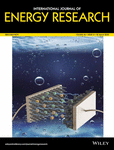Influence of Nafion loading in the anode catalyst layer on the performance of anion-exchange membrane direct formate fuel cells
Funding information: Ministry of Science and Technology, Taiwan, Grant/Award Number: MOST 108-2628-E-992-001-MY3
Summary
Anion-exchange membrane direct formate fuel cells (AEM DFFCs) were fabricated and tested at various fuel and electrolyte concentrations ranging from 1 to 5 M, flow rates ranging from 1 to 5 mL/min, and cell temperatures ranging from room temperature to 60°C with varying Nafion ionomer contents in the anode. A mixture of potassium formate (HCOOK) and potassium hydroxide (KOH) was fed into the serpentine anolyte flow field, while the air was forced into the serpentine air flow field at 100 sccm. The results revealed that feeding DFFCs with an anolyte solution containing 3-M HCOOK in 3-M KOH yielded the best cell output, compared to using an anolyte solution containing higher fuel and electrolyte concentrations. According to an empirical model investigation of the AEM DFFCs performance, reducing the Nafion ionomer content induced a rise in the exchange current density and the fuel crossover equivalent current density but resulted in a drop in the DFFCs' area-specific resistance. In this investigation, the optimum Nafion ionomer content in the anode was 1.87 mg/cm2. The maximum power density of the DFFCs tested at ambient temperature and 60°C were 94.78 mW/cm2 and 115.3 mW/cm2, respectively, as the AEM DFFCs were fed with anolyte containing 3-M HCOOK in 3-M KOH at 5 mL/min with anode Nafion ionomer content of 1.87 mg/cm2.
Open Research
DATA AVAILABILITY STATEMENT
Author elects to not share data.




